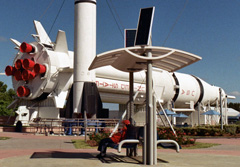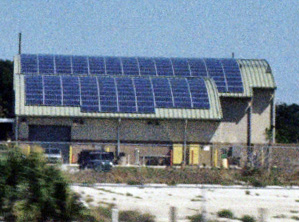If Solar is Good Enough for NASA, It is Good Enough for the Rest of Us

Endeavour on the Launch Pad
Last week, I took my kids to watch the shuttle launch from Cape Canaveral in Florida. The launch was supposed to be the final launch of Endeavour and the second to last launch of the shuttle before the fleet is retired this summer. Mindful of the vagaries of the weather and the unpredictability of technical problems, we waited until the last minute to make our non-refundable reservations. We may not have seen the shuttle launch, but we did see some pretty impressive displays of how NASA is using solar energy here on Earth.

Solar Lights at Kennedy Space Center
It looked like all systems were go and NASA was predicting that the weather would cooperate—up to a 80% confidence level. I took it as a hopeful sign that President Obama was taking his kids to watch the launch. Still recovering from a would-be assassin’s bullet, Congresswoman Gabrielle Giffords was on hand to watch her husband NASA astronaut Mark Kelley blast off into space as Endeavour’s commander. It appeared that the stars had aligned (sorry for the pun) for us to watch the launch.
We found an ideal vantage point in Titusville, just across the Indian River, the body of water that separates the Kennedy Space Center from the mainland. We found a patch of open space where we could lay out our blanket and met our fellow shuttle launch observers from Texas and British Columbia. Yes, we quickly learned that we were certainly not the ones who had travelled the furthest to watch the launch. We were just settling in for the 3 ½ hour wait, when we heard the news that the launch had been scrubbed, and that the final launch of Endeavour would have to wait for another day.
We held out hope that there would be only a brief delay and since our return flight was not for another three days, we decided to tour the Kennedy Space Center during our visit to Florida. We were well familiar with NASA’s innovation of solar energy to power space orbiters and the International Space Station, but we were less familiar with NASA’s application of solar energy to power unexciting objects here on Earth.
The Kennedy Center Visitor Center uses solar energy for some mundane applications such as solar lighting for pathways and sitting areas. NASA uses solar on its buildings such as some of the auxiliary building near the grandiose Vehicle Assembly Building. And as recently as 2009, NASA inaugurated the Kennedy Solar Energy Center, where it installed over 3000 solar panels with a capacity of 1 megawatt of electricity. We didn’t get a photo of the solar farm with all of these solar panels, but we did get a glimpse of some of the NASA buildings graced with solar panels.![]()
We did not hide our disappointment at not seeing the Shuttle blast off into the cosmos. By all accounts, that is a remarkable experience for those who have had the privilege of watching men and women reach for the stars. We may have to settle for the next generation of space shuttles. We were pleased, however, to see how NASA is utilizing the rays of the sun not only in the cosmos, but here on Earth. And if it is good enough for NASA, then solar is good enough for the rest of us.
